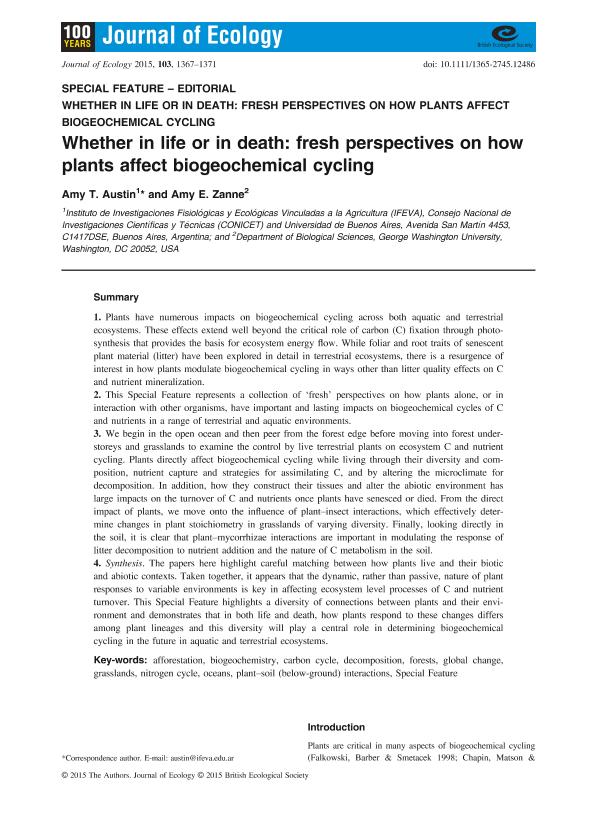Mostrar el registro sencillo del ítem
dc.contributor.author
Austin, Amy Theresa

dc.contributor.author
Zanne, Amy E.
dc.date.available
2017-06-05T19:48:20Z
dc.date.issued
2015-11
dc.identifier.citation
Austin, Amy Theresa; Zanne, Amy E.; Whether in life or in death: fresh perspectives on how plants affect biogeochemical cycling; Wiley; Journal Of Ecology; 103; 6; 11-2015; 1367-1371
dc.identifier.issn
0022-0477
dc.identifier.uri
http://hdl.handle.net/11336/17520
dc.description.abstract
1. Plants have numerous impacts on biogeochemical cycling across both aquatic and terrestrial ecosystems. These effects extend well beyond the critical role of carbon (C) fixation through photosynthesis that provides the basis for ecosystem energy flow. While foliar and root traits of senescent plant material (litter) have been explored in detail in terrestrial ecosystems, there is a resurgence of interest in how plants modulate biogeochemical cycling in ways other than litter quality effects on C and nutrient mineralization. 2. This Special Feature represents a collection of ‘fresh’ perspectives on how plants alone, or in interaction with other organisms, have important and lasting impacts on biogeochemical cycles of C and nutrients in a range of terrestrial and aquatic environments. 3. We begin in the open ocean and then peer from the forest edge before moving into forest understoreys and grasslands to examine the control by live terrestrial plants on ecosystem C and nutrient cycling. Plants directly affect biogeochemical cycling while living through their diversity and composition, nutrient capture and strategies for assimilating C, and by altering the microclimate for decomposition. In addition, how they construct their tissues and alter the abiotic environment has large impacts on the turnover of C and nutrients once plants have senesced or died. From the direct impact of plants, we move onto the influence of plant–insect interactions, which effectively determine changes in plant stoichiometry in grasslands of varying diversity. Finally, looking directly in the soil, it is clear that plant–mycorrhizae interactions are important in modulating the response of litter decomposition to nutrient addition and the nature of C metabolism in the soil. 4. Synthesis. The papers here highlight careful matching between how plants live and their biotic and abiotic contexts. Taken together, it appears that the dynamic, rather than passive, nature of plant responses to variable environments is key in affecting ecosystem level processes of C and nutrient turnover. This Special Feature highlights a diversity of connections between plants and their environment and demonstrates that in both life and death, how plants respond to these changes differs among plant lineages and this diversity will play a central role in determining biogeochemical cycling in the future in aquatic and terrestrial ecosystems.
dc.format
application/pdf
dc.language.iso
eng
dc.publisher
Wiley

dc.rights
info:eu-repo/semantics/openAccess
dc.rights.uri
https://creativecommons.org/licenses/by-nc-sa/2.5/ar/
dc.subject
Editorial
dc.subject
Biogeochemistry
dc.subject
Plant Soil Interactions
dc.subject
Aquatic And Terrestrial Ecosystems
dc.subject.classification
Ecología

dc.subject.classification
Ciencias Biológicas

dc.subject.classification
CIENCIAS NATURALES Y EXACTAS

dc.title
Whether in life or in death: fresh perspectives on how plants affect biogeochemical cycling
dc.type
info:eu-repo/semantics/article
dc.type
info:ar-repo/semantics/artículo
dc.type
info:eu-repo/semantics/publishedVersion
dc.date.updated
2017-06-02T17:32:19Z
dc.journal.volume
103
dc.journal.number
6
dc.journal.pagination
1367-1371
dc.journal.pais
Estados Unidos

dc.journal.ciudad
Hoboken
dc.description.fil
Fil: Austin, Amy Theresa. Consejo Nacional de Investigaciones Científicas y Técnicas. Oficina de Coordinación Administrativa Parque Centenario. Instituto de Investigaciones Fisiológicas y Ecológicas Vinculadas a la Agricultura. Universidad de Buenos Aires. Facultad de Agronomía. Instituto de Investigaciones Fisiológicas y Ecológicas Vinculadas a la Agricultura; Argentina
dc.description.fil
Fil: Zanne, Amy E.. The George Washington University; Estados Unidos
dc.journal.title
Journal Of Ecology

dc.relation.alternativeid
info:eu-repo/semantics/altIdentifier/doi/http://dx.doi.org/10.1111/1365-2745.12486
dc.relation.alternativeid
info:eu-repo/semantics/altIdentifier/url/http://onlinelibrary.wiley.com/doi/10.1111/1365-2745.12486/abstract
Archivos asociados
